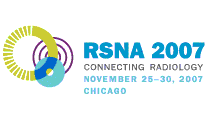
Abstract Archives of the RSNA, 2007
LL-PH6116-B06
Implementation of Multi-energy Micro Computed Tomography Post-reconstruction Material Decomposition
Scientific Posters
Presented on November 25, 2007
Presented as part of LL-PH-B: Physics - CT
Patrick Vincent Granton BSc, Presenter: Nothing to Disclose
David W. Holdsworth PhD, Abstract Co-Author: Nothing to Disclose
Maria Drangova PhD, Abstract Co-Author: Nothing to Disclose
Steve Pollmann BSc, Abstract Co-Author: Nothing to Disclose
A limitation of Computed Tomographic images is that two materials (such as cortical bone and vascular CT contrast agent Microfil MV-122) may share similar grey scale values, making it difficult to perform image segmentation by image intensity alone. By scanning a specimen at two or more different mean x-ray energies (referred to as Dual-Energy Computed Tomography–DECT or k-edge imaging) we can attempt to decompose bone from vessels with the specific intent to form 3D concentration specific images of bone, vessels and tissue of a Microfil-perfused rat.
Three scanning protocols were implement using the GE explore Locus Ultra flat panel cone beam micro-CT scanner: two giving the widest energy separation achievable (required for Dual-Energy studies) and the third to provide a mean energy just below the k-edge of lead (a component of Microfil). Using x-ray tube potentials 70 and 140kVp with added filtration of 0.3mm Pb and 1.45mm CU to the high energy scans, the effective mean x-ray energies were 43, 77 and 87 KeV, respectively. Serving to validate and quantify the material decomposition technique, scans were preformed on a phantom containing chambers of: contrast agent Microfil, SB3 (a cortical bone mimicking epoxy) and water. Following phantom studies a Microfil-perfused rat post-mortem was imaged and decomposed into 3D concentration specific images of bone, vessel (Microfil) and tissue.
We have found that the 77KeV and 88KeV spectral pair (filtered with Pb and Cu, respectively) provides the optimal material decomposition. Material classification accuracy was 95% in numerical studies and 90% in experimental scans.
Dual-energy cone beam micro-CT acquisition, using mean energies that straddle the k-edge of lead provides adequate decomposition into bone, vessel(Microfil), and soft tissue. This new technique can be applied in future ex vivo studies of the rodent skeleton and vasculature.
My research group, which has developed a rat model of osteoarthritis, intends to use multi-energy micro-CT to isolate the vasculature near bone to better understand this degenerative joint disease.
Granton, P,
Holdsworth, D,
Drangova, M,
Pollmann, S,
Implementation of Multi-energy Micro Computed Tomography Post-reconstruction Material Decomposition. Radiological Society of North America 2007 Scientific Assembly and Annual Meeting, November 25 - November 30, 2007 ,Chicago IL.
http://archive.rsna.org/2007/5009576.html

